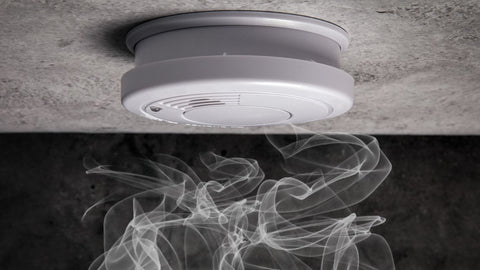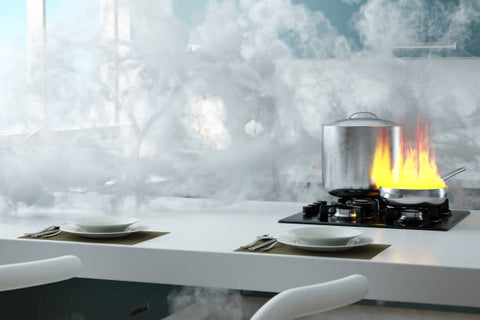Heat Alarms - A Complete Guide
The Importance of Installing a Heat Alarm
A heat alarm is a critical component of any home safety plan, designed to detect and alert you to the presence of a fire. Unlike smoke alarms, which detect smoke and other airborne particles, heat alarms are specifically designed to detect rapid increases in temperature.
Heat alarms provide an early warning of a fire, giving you and your family time to evacuate the premises. This is why it is so important to have a heat alarm installed in your home. In this comprehensive guide, we will explore everything you need to know about heat alarms, including their purpose, types, features, and how to choose the right one for your home.

Why do you need a heat alarm?
Fires can start for many reasons, including electrical malfunctions, cooking accidents, and heating system failures. The heat generated by a fire can reach dangerous levels within minutes, making it essential to have a heat alarm installed in your home.
Heat alarms are particularly important for kitchens, garages, and other areas of the home where heat-producing appliances are located. These appliances, such as stoves and water heaters, can pose a fire risk if not used properly. By installing a heat alarm in these areas, you can be alerted to the presence of a fire, even if you are not in the room, giving you time to evacuate the premises.
Different Types
There are two main types of heat alarms: fixed temperature heat alarms and rate-of-rise heat alarms.
Fixed temperature heat alarms are designed to activate when the temperature in the room reaches a specific, pre-set level. This type of heat alarm is best suited for areas of the home where heat-producing appliances are located, such as kitchens and garages.
Rate-of-rise heat alarms are designed to detect rapid increases in temperature. These alarms activate when the temperature in the room rises quickly, indicating the presence of a fire. Rate-of-rise heat alarms are ideal for homes with central heating systems, as they can detect fires that are not caused by heat-producing appliances.

Features
When choosing a heat alarm, there are several features to consider, including:
-
Interconnectivity: Some heat alarms can be interconnected with other alarms in the home, allowing all alarms to sound when one is activated. This feature is particularly useful for larger homes, as it ensures that all occupants are alerted to the presence of a fire.
-
Battery backup: Some heat alarms are equipped with a battery backup, allowing them to function even during power outages. This feature is important for homes that are located in areas with frequent power outages, as it ensures that the heat alarm will function even during these times.
-
Test button: A test button is an essential feature of any heat alarm. This button allows you to test the alarm to ensure that it is working correctly.
-
Loud alarm: A loud alarm is an essential feature of any heat alarm. This feature ensures that the alarm can be heard throughout the home, even in noisy areas.
-
Alert options: Some heat alarms have multiple alert options, including audible alarms, visual alerts, and silent alerts. Choose a heat alarm that has the alert options that are most suitable for your home.
Do I Need A Heat Alarm In My Kitchen?
Yes, it is recommended to install a heat alarm in your kitchen. The kitchen is one of the most common areas of the home where fires start, often due to cooking accidents or malfunctioning appliances. A heat alarm in the kitchen can detect rapid increases in temperature, indicating the presence of a fire, and alert you to evacuate the premises. This early warning can be crucial in preventing serious damage to your home and ensuring the safety of you and your family.

Where Is The Best Place To Put A Heat Alarm?
Heat alarms are typically placed in areas where heat buildup is most likely to occur, such as kitchens, garages, and near fireplaces. Here are some general guidelines to consider when installing a heat alarm:
-
High temperature zones: Place heat alarms near high temperature zones, such as the kitchen stove, oven, or near fireplaces, where fires are most likely to start.
-
Ceiling placement: Heat alarms should be mounted on the ceiling, away from walls and windows, as hot air rises.
-
Avoid false alarms: Avoid placing heat alarms near vents, radiators, or other sources of hot air that may cause false alarms.
-
Interconnectivity: Consider interconnecting all smoke and heat alarms in your home, so that when one sounds, they all sound.
-
Read manufacturer's instructions: Always make sure to read the manufacturer's instructions for the specific heat alarm you have, as different models may have different placement requirements.
Remember, the most important thing is to place heat alarms in areas where they can provide the earliest warning in case of a fire.
How Long Does a Heat Alarm Last?
The lifespan of a heat alarm depends on several factors, including the type of heat alarm, the manufacturer, and the environmental conditions in which the alarm is used. On average, heat alarms can last anywhere from 7 to 10 years.
It's important to check the manufacturer's specifications for the specific heat alarm you have, as some models may have a shorter or longer lifespan. Regular maintenance, such as cleaning the alarm and testing its batteries, can help extend the life of a heat alarm and ensure that it continues to function properly.
Regardless of the lifespan of a heat alarm, it's recommended to replace it every 10 years or sooner if it begins to show signs of wear or malfunction. This will help ensure that you have a properly functioning heat alarm in case of a fire.
Can a Heat Alarm Be Placed On The Wall?
Yes, some heat alarms can be placed on a wall. However, it is generally recommended to place heat alarms on the ceiling, as hot air rises and heat detectors on the ceiling are more likely to detect a fire at its earliest stages.
If you do choose to place a heat alarm on a wall, make sure to follow the manufacturer's instructions carefully. Some heat alarms are specifically designed for wall placement and may have different placement requirements than those designed for ceiling placement.
In general, it's important to make sure that the heat alarm is placed in an area where it won't be blocked by furniture, curtains, or other objects, and where it can detect heat from all directions.
Brands We Stock

